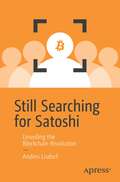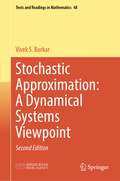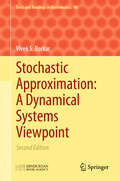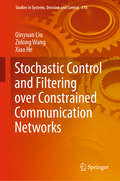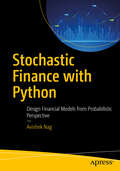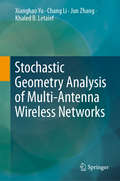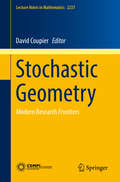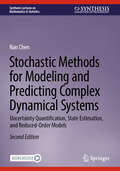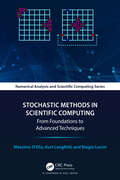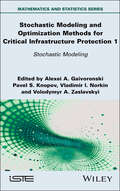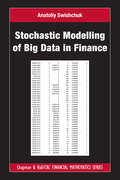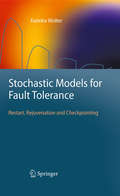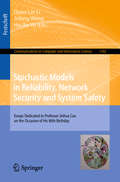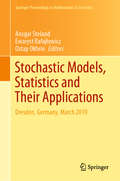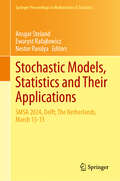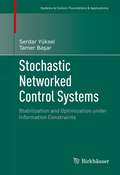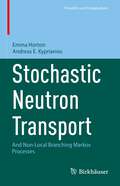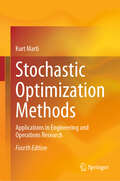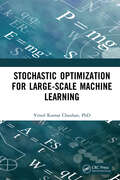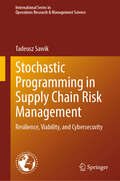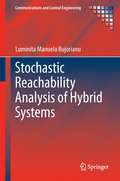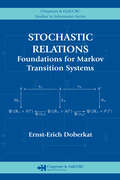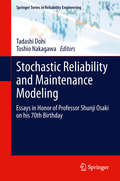- Table View
- List View
Still Searching for Satoshi: Unveiling the Blockchain Revolution
by Anders LisdorfWe are at the threshold of a new area of the internet that promises to transform the way we engage financially and take the power of data and privacy back from big corporations and give it to the individual through decentralization. This is sometimes called Web 3.0. While Web 1.0 transformed information sharing and commerce and brought us giants like Google and Amazon and Web 2.0 unlocked the social potential of the internet and created Facebook, Twitter, and Snapchat, exactly what will come of Web 3.0 remains to be seen. It is indisputable that the seed of Web 3.0 is the technological, social, and economic innovations that came together in Bitcoin and the blockchain technology it created. But where the first web iterations were relatively straightforward to understand, the inner workings of Web 3.0 remain more opaque and shrouded in mystique. Current voices on Bitcoin and the blockchain revolution fall squarely into one of two camps; either technological “experts” who are all also invariably personally invested in the success of Bitcoin and the blockchain or “critics” who are typically deeply invested in the status quo and the failure of Bitcoin and blockchain. It seems like there is a need for a middle ground to provide the public with a more unbiased view of this important technology. This book therefore aims to unveil some of the mystique and show how to unlock the potential of the blockchain revolution in a manner that does not dismiss out of hand even radical and outlandish ideas nor jumps on the bandwagon of hailing Bitcoin and the blockchain as the answer to all problems. What you’ll learn The nature of blockchain technology, how it works and what it does.The history of the technological developments that lead to the blockchain.A historical analysis of who the likely creator of Bitcoin is.How bitcoin and cryptocurrencies fit in the history of human exchange.The nature and history of electronic money.How blockchain technology solves problems in a novel way and what it cannot be used for.What web 3.0 could be. Who This Book Is For This book is for a general non-technical audience trying to understand the difficult and complex nature of blockchain and cryptocurrencies and the contours of the Web 3.0 revolution.
Stochastic Approaches to Electron Transport in Micro- and Nanostructures (Modeling and Simulation in Science, Engineering and Technology)
by Ivan Dimov Siegfried Selberherr Mihail NedjalkovThe book serves as a synergistic link between the development of mathematical models and the emergence of stochastic (Monte Carlo) methods applied for the simulation of current transport in electronic devices. Regarding the models, the historical evolution path, beginning from the classical charge carrier transport models for microelectronics to current quantum-based nanoelectronics, is explicatively followed. Accordingly, the solution methods are elucidated from the early phenomenological single particle algorithms applicable for stationary homogeneous physical conditions up to the complex algorithms required for quantum transport, based on particle generation and annihilation. The book fills the gap between monographs focusing on the development of the theory and the physical aspects of models, their application, and their solution methods and monographs dealing with the purely theoretical approaches for finding stochastic solutions of Fredholm integral equations.
Stochastic Approximation: A Dynamical Systems Viewpoint (Texts and Readings in Mathematics #48)
by Vivek S. BorkarThis book serves as an advanced text for a graduate course on stochastic algorithms for the students of probability and statistics, engineering, economics and machine learning. This second edition gives a comprehensive treatment of stochastic approximation algorithms based on the ordinary differential equation (ODE) approach which analyses the algorithm in terms of a limiting ODE. It has a streamlined treatment of the classical convergence analysis and includes several recent developments such as concentration bounds, avoidance of traps, stability tests, distributed and asynchronous schemes, multiple time scales, general noise models, etc., and a category-wise exposition of many important applications. It is also a useful reference for researchers and practitioners in the field.
Stochastic Approximation: Second Edition (Texts and Readings in Mathematics #48)
by Vivek S. BorkarThis book serves as an advanced text for a graduate course on stochastic algorithms for graduate students in probability and statistics, engineering, economics and machine learning. This second edition gives a comprehensive treatment of stochastic approximation algorithms based on the “ordinary differential equation (ODE) approach” which analyses the algorithm in terms of a limiting ODE. It has a streamlined treatment of the classical convergence analysis and includes several recent developments such as concentration bounds, avoidance of traps, stability tests, distributed and asynchronous schemes, multiple time scales, general noise models, etc., and a category-wise exposition of many important applications. It is also a useful reference for researchers and practitioners in the field.
Stochastic Control and Filtering over Constrained Communication Networks (Studies in Systems, Decision and Control #178)
by Zidong Wang Qinyuan Liu Xiao HeStochastic Control and Filtering over Constrained Communication Networks presents up-to-date research developments and novel methodologies on stochastic control and filtering for networked systems under constrained communication networks. It provides a framework of optimal controller/filter design, resilient filter design, stability and performance analysis for the systems considered, subject to various kinds of communication constraints, including signal-to-noise constraints, bandwidth constraints, and packet drops. Several techniques are employed to develop the controllers and filters desired, including:recursive Riccati equations;matrix decomposition;optimal estimation theory; andmathematical optimization methods.Readers will benefit from the book’s new concepts, models and methodologies that have practical significance in control engineering and signal processing. Stochastic Control and Filtering over Constrained Communication Networks is a practical research reference for engineers dealing with networked control and filtering problems. It is also of interest to academics and students working in control and communication networks.
Stochastic Finance with Python: Design Financial Models from Probabilistic Perspective
by Avishek NagJourney through the world of stochastic finance from learning theory, underlying models, and derivations of financial models (stocks, options, portfolios) to the almost production-ready Python components under cover of stochastic finance. This book will show you the techniques to estimate potential financial outcomes using stochastic processes implemented with Python. The book starts by reviewing financial concepts, such as analyzing different asset types like stocks, options, and portfolios. It then delves into the crux of stochastic finance, providing a glimpse into the probabilistic nature of financial markets. You’ll look closely at probability theory, random variables, Monte Carlo simulation, and stochastic processes to cover the prerequisites from the applied perspective. Then explore random walks and Brownian motion, essential in understanding financial market dynamics. You’ll get a glimpse of two vital modelling tools used throughout the book - stochastic calculus and stochastic differential equations (SDE). Advanced topics like modeling jump processes and estimating their parameters by Fourier-transform-based density recovery methods can be intriguing to those interested in full-numerical solutions of probability models. Moving forward, the book covers options, including the famous Black-Scholes model, dissecting it from both risk-neutral probability and PDE perspectives. A chapter at the end also covers the discovery of portfolio theory, beginning with mean-variance analysis and advancing to portfolio simulation and the efficient frontier. What You Will Learn Understand applied probability and statistics with finance Design forecasting models of the stock price with the stochastic process, Monte-Carlo simulation. Option price estimation with both risk-neutral probabilistic and PDE-driven approach. Use Object-oriented Python to design financial models with reusability. Who This Book Is For Data scientists, quantitative researchers and practitioners, software engineers and AI architects interested in quantitative finance
Stochastic Geometry Analysis of Multi-Antenna Wireless Networks
by Jun Zhang Xianghao Yu Chang Li Khaled B. LetaiefThis book presents a unified framework for the tractable analysis of large-scale, multi-antenna wireless networks using stochastic geometry. This mathematical analysis is essential for assessing and understanding the performance of complicated multi-antenna networks, which are one of the foundations of 5G and beyond networks to meet the ever-increasing demands for network capacity. Describing the salient properties of the framework, which makes the analysis of multi-antenna networks comparable to that of their single-antenna counterparts, the book discusses effective design approaches that do not require complex system-level simulations. It also includes various application examples with different multi-antenna network models to illustrate the framework’s effectiveness.
Stochastic Geometry for Wireless Networks
by Martin HaenggiCovering point process theory, random geometric graphs and coverage processes, this rigorous introduction to stochastic geometry will enable you to obtain powerful, general estimates and bounds of wireless network performance and make good design choices for future wireless architectures and protocols that efficiently manage interference effects. Practical engineering applications are integrated with mathematical theory, with an understanding of probability the only prerequisite. At the same time, stochastic geometry is connected to percolation theory and the theory of random geometric graphs and accompanied by a brief introduction to the R statistical computing language. Combining theory and hands-on analytical techniques with practical examples and exercises, this is a comprehensive guide to the spatial stochastic models essential for modelling and analysis of wireless network performance.
Stochastic Geometry: Modern Research Frontiers (Lecture Notes in Mathematics #2237)
by David CoupierThis volume offers a unique and accessible overview of the most active fields in Stochastic Geometry, up to the frontiers of recent research. Since 2014, the yearly meeting of the French research structure GDR GeoSto has been preceded by two introductory courses. This book contains five of these introductory lectures. The first chapter is a historically motivated introduction to Stochastic Geometry which relates four classical problems (the Buffon needle problem, the Bertrand paradox, the Sylvester four-point problem and the bicycle wheel problem) to current topics. The remaining chapters give an application motivated introduction to contemporary Stochastic Geometry, each one devoted to a particular branch of the subject: understanding spatial point patterns through intensity and conditional intensities; stochastic methods for image analysis; random fields and scale invariance; and the theory of Gibbs point processes. Exposing readers to a rich theory, this book will encourage further exploration of the subject and its wide applications.
Stochastic Methods for Modeling and Predicting Complex Dynamical Systems: Uncertainty Quantification, State Estimation, and Reduced-Order Models (Synthesis Lectures on Mathematics & Statistics)
by Nan ChenThis Second Edition is an essential guide to understanding, modeling, and predicting complex dynamical systems using new methods with stochastic tools. Expanding upon the original book, the author covers a unique combination of qualitative and quantitative modeling skills, novel efficient computational methods, rigorous mathematical theory, as well as physical intuitions and thinking. The author presents mathematical tools for understanding, modeling, and predicting complex dynamical systems using various suitable stochastic tools. The book provides practical examples and motivations when introducing these tools, merging mathematics, statistics, information theory, computational science, and data science. The author emphasizes the balance between computational efficiency and modeling accuracy while equipping readers with the skills to choose and apply stochastic tools to a wide range of disciplines. This second edition includes updated discussion of combining stochastic models with machine learning and addresses several additional topics, including importance sampling, regression, and maximum likelihood estimate. The author also introduces a new chapter on optimal control.
Stochastic Methods in Scientific Computing: From Foundations to Advanced Techniques (Chapman & Hall/CRC Numerical Analysis and Scientific Computing Series)
by Massimo D'Elia Kurt Langfeld Biagio LuciniStochastic Methods in Scientific Computing: From Foundations to Advanced Techniques introduces the reader to advanced concepts in stochastic modelling, rooted in an intuitive yet rigorous presentation of the underlying mathematical concepts. A particular emphasis is placed on illuminating the underpinning Mathematics, and yet have the practical applications in mind. The reader will find valuable insights into topics ranging from Social Sciences and Particle Physics to modern-day Computer Science with Machine Learning and AI in focus. The book also covers recent specialised techniques for notorious issues in the field of stochastic simulations, providing a valuable reference for advanced readers with an active interest in the field.Features Self-contained, starting from the theoretical foundations and advancing to the most recent developments in the field Suitable as a reference for post-graduates and researchers or as supplementary reading for courses in numerical methods, scientific computing, and beyond Interdisciplinary, laying a solid ground for field-specific applications in finance, physics and biosciences on common theoretical foundations Replete with practical examples of applications to classic and current research problems in various fields.
Stochastic Modeling and Optimization Methods for Critical Infrastructure Protection, Volume 2: Methods and Tools (ISTE Invoiced)
by Pavel S. Knopov Alexei A. Gaivoronski Volodymyr A. Zaslavskyi Vladimir I. NorkinStochastic Modeling and Optimization Methods for Critical Infrastructure Protection is a thorough exploration of mathematical models and tools that are designed to strengthen critical infrastructures against threats – both natural and adversarial. Divided into two volumes, this first volume examines stochastic modeling across key economic sectors and their interconnections, while the second volume focuses on advanced mathematical methods for enhancing infrastructure protection. The book covers a range of themes, including risk assessment techniques that account for systemic interdependencies within modern technospheres, the dynamics of uncertainty, instability and system vulnerabilities. The book also presents other topics such as cryptographic information protection and Shannon’s theory of secret systems, alongside solutions arising from optimization, game theory and machine learning approaches. Featuring research from international collaborations, this book covers both theory and applications, offering vital insights for advanced risk management curricula. It is intended not only for researchers, but also educators and professionals in infrastructure protection and stochastic optimization.
Stochastic Modelling of Big Data in Finance (Chapman and Hall/CRC Financial Mathematics Series)
by Anatoliy SwishchukStochastic Modelling of Big Data in Finance provides a rigorous overview and exploration of sto- chastic modelling of big data in finance (BDF). The book describes various stochastic models, including multivariate models, to deal with big data in finance. This includes data in high-frequency and algorithmic trading, specifically in limit order books (LOB), and shows how those models can be applied to different datasets to describe the dynamics of LOB, and to figure out which model is the best with respect to a specific data set. The results of the book may be used to also solve acquisition, liquidation and market making problems, and other optimization problems in finance.Features• Self-contained book suitable for graduate students and post-doctoral fellows in financial math- ematics and data science, as well as for practitioners working in the financial industry who deal with big data• All results are presented visually to aid in understanding of concepts Dr. Anatoliy Swishchuk is a Professor in Mathematical Finance at the Department of Mathematics and Statistics, University of Calgary, Calgary, AB, Canada. He got his B.Sc. and M.Sc. degrees from Kyiv State University, Kyiv, Ukraine. He earned two doctorate degrees in Mathematics and Physics (PhD and DSc) from the prestigious National Academy of Sciences of Ukraine (NASU), Kiev, Ukraine, and is a recipient of NASU award for young scientist with a gold medal for series of research publica- tions in random evolutions and their applications.Dr. Swishchuk is a chair and organizer of finance and energy finance seminar ‘Lunch at the Lab’ at the Department of Mathematics and Statistics. Dr. Swishchuk is a Director of Mathematical and Compu- tational Finance Laboratory at the University of Calgary. He was a steering committee member of the Professional Risk Managers International Association (PRMIA), Canada (2006-2015), and is a steer- ing committee member of Global Association of Risk Professionals (GARP), Canada (since 2015).Dr. Swishchuk is a creator of mathematical finance program at the Department of Mathematics & Sta- tistics. He is also a proponent for a new specialization “Financial and Energy Markets Data Modelling” in the Data Science and Analytics program. His research areas include financial mathematics, ran- dom evolutions and their applications, biomathematics, stochastic calculus, and he serves on editorial boards for four research journals. He is the author of more than 200 publications, including 15 books and more than 150 articles in peer-reviewed journals. In 2018 he received a Peak Scholar award.
Stochastic Models for Fault Tolerance
by Katinka WolterAs modern society relies on the fault-free operation of complex computing systems, system fault-tolerance has become an indispensable requirement. Therefore, we need mechanisms that guarantee correct service in cases where system components fail, be they software or hardware elements. Redundancy patterns are commonly used, for either redundancy in space or redundancy in time. Wolter's book details methods of redundancy in time that need to be issued at the right moment. In particular, she addresses the so-called "timeout selection problem", i.e., the question of choosing the right time for different fault-tolerance mechanisms like restart, rejuvenation and checkpointing. Restart indicates the pure system restart, rejuvenation denotes the restart of the operating environment of a task, and checkpointing includes saving the system state periodically and reinitializing the system at the most recent checkpoint upon failure of the system. Her presentation includes a brief introduction to the methods, their detailed stochastic description, and also aspects of their efficient implementation in real-world systems. The book is targeted at researchers and graduate students in system dependability, stochastic modeling and software reliability. Readers will find here an up-to-date overview of the key theoretical results, making this the only comprehensive text on stochastic models for restart-related problems.
Stochastic Models in Reliability, Network Security and System Safety: Essays Dedicated to Professor Jinhua Cao on the Occasion of His 80th Birthday (Communications in Computer and Information Science #1102)
by Quan-Lin Li Jinting Wang Hai-Bo YuThis book is dedicated to Jinhua Cao on the occasion of his 80th birthday. Jinhua Cao is one of the most famous reliability theorists. His main contributions include: published over 100 influential scientific papers; published an interesting reliability book in Chinese in 1986, which has greatly influenced the reliability of education, academic research and engineering applications in China; initiated and organized Reliability Professional Society of China (the first part of Operations Research Society of China) since 1981. The high admiration that Professor Cao enjoys in the reliability community all over the world was witnessed by the enthusiastic response of each contributor in this book. The contributors are leading researchers with diverse research perspectives. The research areas of the book iclude a broad range of topics related to reliability models, queueing theory, manufacturing systems, supply chain finance, risk management, Markov decision processes, blockchain and so forth.The book consists of a brief Preface describing the main achievements of Professor Cao; followed by congratulations from Professors Way Kuo and Wei Wayne Li, and by Operations Research Society of China, and Reliability Professional Society of China; and further followed by 25 articles roughly grouped together. Most of the articles are written in a style understandable to a wide audience. This book is useful to anyone interested in recent developments in reliability, network security, system safety, and their stochastic modeling and analysis.
Stochastic Models, Statistics and Their Applications: Dresden, Germany, March 2019 (Springer Proceedings in Mathematics & Statistics #294)
by Ansgar Steland Ewaryst Rafajłowicz Ostap OkhrinThis volume presents selected and peer-reviewed contributions from the 14th Workshop on Stochastic Models, Statistics and Their Applications, held in Dresden, Germany, on March 6-8, 2019. Addressing the needs of theoretical and applied researchers alike, the contributions provide an overview of the latest advances and trends in the areas of mathematical statistics and applied probability, and their applications to high-dimensional statistics, econometrics and time series analysis, statistics for stochastic processes, statistical machine learning, big data and data science, random matrix theory, quality control, change-point analysis and detection, finance, copulas, survival analysis and reliability, sequential experiments, empirical processes, and microsimulations. As the book demonstrates, stochastic models and related statistical procedures and algorithms are essential to more comprehensively understanding and solving present-day problems arising in e.g. the natural sciences, machine learning, data science, engineering, image analysis, genetics, econometrics and finance.
Stochastic Models, Statistics and Their Applications: SMSA 2024, Delft, The Netherlands, March 13-15 (Springer Proceedings in Mathematics & Statistics #499)
by Ansgar Steland Ewaryst Rafajłowicz Nestor ParolyaThis volume presents contemporary research in stochastic modeling, statistical inference and their applications, and collects peer-reviewed contributions presented at the 15th Workshop on Stochastic Models, Statistics and Their Applications, SMSA 2024, held in Delft, The Netherlands, March 13-15, 2024. It brings together a unique mix of authors, working on theoretical and applied problems, and addresses a wide variety of topics from the workshop&’s focus areas, which included Bayesian methods, change point analysis, computational statistics, econometrics, high-dimensional, nonparametric and spatial statistics, statistical process monitoring, statistics for stochastic processes, and sequential and time series analysis. The volume is structured in three parts, covering stochastics and statistical theory, statistical inference and machine learning, and testing for patterns in data. The contributions discuss highly active research topics, such as strong approximation in high dimensions, modeling and testing multivariate distributions, the interplay and fusion of statistical ideas and machine learning, approaches to handling discrete and ordinal data, and detection of hidden patterns in data, with applications to environmental science, business and engineering.
Stochastic Networked Control Systems
by Tamer Başar Serdar YükselNetworked control systems are increasingly ubiquitous today, with applications ranging from vehicle communication and adaptive power grids to space exploration and economics. The optimal design of such systems presents major challenges, requiring tools from various disciplines within applied mathematics such as decentralized control, stochastic control, information theory, and quantization. A thorough, self-contained book, Stochastic Networked Control Systems: Stabilization and Optimization under Information Constraints aims to connect these diverse disciplines with precision and rigor, while conveying design guidelines to controller architects. Unique in the literature, it lays a comprehensive theoretical foundation for the study of networked control systems, and introduces an array of concrete tools for work in the field. Salient features included: · Characterization, comparison and optimal design of information structures in static and dynamic teams. Operational, structural and topological properties of information structures in optimal decision making, with a systematic program for generating optimal encoding and control policies. The notion of signaling, and its utilization in stabilization and optimization of decentralized control systems. · Presentation of mathematical methods for stochastic stability of networked control systems using random-time, state-dependent drift conditions and martingale methods. · Characterization and study of information channels leading to various forms of stochastic stability such as stationarity, ergodicity, and quadratic stability; and connections with information and quantization theories. Analysis of various classes of centralized and decentralized control systems. · Jointly optimal design of encoding and control policies over various information channels and under general optimization criteria, including a detailed coverage of linear-quadratic-Gaussian models. · Decentralized agreement and dynamic optimization under information constraints. This monograph is geared toward a broad audience of academic and industrial researchers interested in control theory, information theory, optimization, economics, and applied mathematics. It could likewise serve as a supplemental graduate text. The reader is expected to have some familiarity with linear systems, stochastic processes, and Markov chains, but the necessary background can also be acquired in part through the four appendices included at the end. · Characterization, comparison and optimal design of information structures in static and dynamic teams. Operational, structural and topological properties of information structures in optimal decision making, with a systematic program for generating optimal encoding and control policies. The notion of signaling, and its utilization in stabilization and optimization of decentralized control systems. · Presentation of mathematical methods for stochastic stability of networked control systems using random-time, state-dependent drift conditions and martingale methods. · Characterization and study of information channels leading to various forms of stochastic stability such as stationarity, ergodicity, and quadratic stability; and connections with information and quantization theories. Analysis of various classes of centralized and decentralized control systems. · Jointly optimal design of encoding and control policies over various information channels and under general optimization criteria, including a detailed coverage of linear-quadratic-Gaussian models. · Decentralized agreement and dynamic optimization under information constraints. This monograph is geared toward a broad audience of academic and industrial researchers interested in control theory, information theory, optimization, economics, and applied mathematics. It could likewise serve as a supplemental graduate text. The reader is expected to have some familiarity with linear systems, stochastic processes, and Markov chai...
Stochastic Neutron Transport: And Non-Local Branching Markov Processes (Probability and Its Applications)
by Andreas E. Kyprianou Emma HortonThis monograph highlights the connection between the theory of neutron transport and the theory of non-local branching processes. By detailing this frequently overlooked relationship, the authors provide readers an entry point into several active areas, particularly applications related to general radiation transport. Cutting-edge research published in recent years is collected here for convenient reference. Organized into two parts, the first offers a modern perspective on the relationship between the neutron branching process (NBP) and the neutron transport equation (NTE), as well as some of the core results concerning the growth and spread of mass of the NBP. The second part generalizes some of the theory put forward in the first, offering proofs in a broader context in order to show why NBPs are as malleable as they appear to be. Stochastic Neutron Transport will be a valuable resource for probabilists, and may also be of interest to numerical analysts and engineers in the field of nuclear research.
Stochastic Optimization Methods: Applications in Engineering and Operations Research
by Kurt MartiThis book examines optimization problems that in practice involve random model parameters. It outlines the computation of robust optimal solutions, i.e., optimal solutions that are insensitive to random parameter variations, where appropriate deterministic substitute problems are needed. Based on the probability distribution of the random data and using decision theoretical concepts, optimization problems under stochastic uncertainty are converted into corresponding deterministic problems.Due to the probabilities and expectations involved, the book also shows how to apply approximative solution techniques. Several deterministic and stochastic approximation methods are provided: Taylor expansion methods, regression and response surface methods (RSM), probability inequalities, multiple linearization of survival/failure domains, discretization methods, convex approximation/deterministic descent directions/efficient points, stochastic approximation and gradient procedures, and differentiation formulas for probabilities and expectations.The fourth edition of this classic text has been carefully and thoroughly revised. It includes new chapters on the solution of stochastic linear programs by discretization of the underlying probability distribution, and on solving deterministic optimization problems by means of controlled random search methods and multiple random search procedures. It also presents a new application of stochastic optimization methods to machine learning problems with different loss functions. For the computation of optimal feedback controls under stochastic uncertainty, besides the open-loop feedback procedures, a new method based on Taylor expansions with respect to the gain parameters is presented. The book is intended for researchers and graduate students who are interested in stochastics, stochastic optimization, and control. It will also benefit professionals and practitioners whose work involves technical, economicand/or operations research problems under stochastic uncertainty.
Stochastic Optimization for Large-scale Machine Learning
by Vinod Kumar ChauhanAdvancements in the technology and availability of data sources have led to the `Big Data' era. Working with large data offers the potential to uncover more fine-grained patterns and take timely and accurate decisions, but it also creates a lot of challenges such as slow training and scalability of machine learning models. One of the major challenges in machine learning is to develop efficient and scalable learning algorithms, i.e., optimization techniques to solve large scale learning problems. Stochastic Optimization for Large-scale Machine Learning identifies different areas of improvement and recent research directions to tackle the challenge. Developed optimisation techniques are also explored to improve machine learning algorithms based on data access and on first and second order optimisation methods. Key Features: Bridges machine learning and Optimisation. Bridges theory and practice in machine learning. Identifies key research areas and recent research directions to solve large-scale machine learning problems. Develops optimisation techniques to improve machine learning algorithms for big data problems. The book will be a valuable reference to practitioners and researchers as well as students in the field of machine learning.
Stochastic Programming in Supply Chain Risk Management: Resilience, Viability, and Cybersecurity (International Series in Operations Research & Management Science #359)
by Tadeusz SawikThis book offers a novel multi-portfolio approach and stochastic programming formulations for modeling and solving contemporary supply chain risk management problems. The focus of the book is on supply chain resilience under propagated disruptions, supply chain viability under severe crises, and supply chain cybersecurity under direct and indirect cyber risks. The content is illustrated with numerous computational examples, some of which are modeled on real-world supply chains subject to severe multi-regional or global crises, such as pandemics. In the computational examples, the proposed stochastic programming models are solved using an advanced algebraic modeling language AMPL and GUROBI solver. The book seamlessly continues the journey begun in the author’s previously published book “Supply Chain Disruption Management: Using Stochastic Mixed Integer Programming.” It equips readers with the knowledge, tools, and managerial insights needed to effectively model and address modern supply chain risk management challenges. As such, the book is designed for practitioners and researchers who are interested in supply chain risk management. Master’s and Ph.D. students in disciplines like supply chain management, operations research, industrial engineering, applied mathematics, and computer science will also find the book a valuable resource.
Stochastic Reachability Analysis of Hybrid Systems
by Luminita Manuela BujorianuStochastic reachability analysis (SRA) is a method of analyzing the behavior of control systems which mix discrete and continuous dynamics. For probabilistic discrete systems it has been shown to be a practical verification method but for stochastic hybrid systems it can be rather more. As a verification technique SRA can assess the safety and performance of, for example, autonomous systems, robot and aircraft path planning and multi-agent coordination but it can also be used for the adaptive control of such systems. Stochastic Reachability Analysis of Hybrid Systems is a self-contained and accessible introduction to this novel topic in the analysis and development of stochastic hybrid systems. Beginning with the relevant aspects of Markov models and introducing stochastic hybrid systems, the book then moves on to coverage of reachability analysis for stochastic hybrid systems. Following this build up, the core of the text first formally defines the concept of reachability in the stochastic framework and then treats issues representing the different faces of SRA: * stochastic reachability based on Markov process theory; * martingale methods; * stochastic reachability as an optimal stopping problem; and * dynamic programming. The book is rounded off by an appendix providing mathematical underpinning on subjects such as ordinary differential equations, probabilistic measure theory and stochastic modeling, which will help the non-expert-mathematician to appreciate the text. Stochastic Reachability Analysis of Hybrid Systems characterizes a highly interdisciplinary area of research and is consequently of significant interest to academic researchers and graduate students from a variety of backgrounds in control engineering, applied mathematics and computer science. The Communications and Control Engineering series reports major technological advances which have potential for great impact in the fields of communication and control. It reflects research in industrial and academic institutions around the world so that the readership can exploit new possibilities as they become available.
Stochastic Relations: Foundations for Markov Transition Systems (Chapman & Hall/CRC Studies in Informatics Series)
by Ernst-Erich DoberkatCollecting information previously scattered throughout the vast literature, including the author's own research, Stochastic Relations: Foundations for Markov Transition Systems develops the theory of stochastic relations as a basis for Markov transition systems.After an introduction to the basic mathematical tools from topology, measure
Stochastic Reliability and Maintenance Modeling
by Toshio Nakagawa Tadashi DohiIn honor of the work of Professor Shunji Osaki, Stochastic Reliability and Maintenance Modeling provides a comprehensive study of the legacy of and ongoing research in stochastic reliability and maintenance modeling. Including associated application areas such as dependable computing, performance evaluation, software engineering, communication engineering, distinguished researchers review and build on the contributions over the last four decades by Professor Shunji Osaki. Fundamental yet significant research results are presented and discussed clearly alongside new ideas and topics on stochastic reliability and maintenance modeling to inspire future research. Across 15 chapters readers gain the knowledge and understanding to apply reliability and maintenance theory to computer and communication systems. Stochastic Reliability and Maintenance Modeling is ideal for graduate students and researchers in reliability engineering, and workers, managers and engineers engaged in computer, maintenance and management works.
